More genre viewing – late Fall 2018
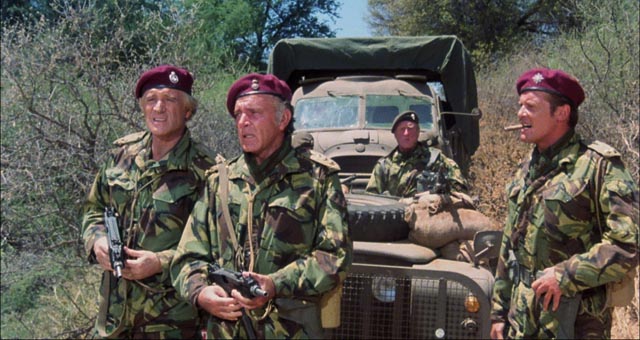
I have to accept that I’ll never get caught up writing just once a week. I also have to face the fact that cinematic art is losing out to pulp by a factor of at least ten-to-one these days. If I stop to think about it, I might start to get worried about mental decline – though when I do get around to watching something more substantial, I still feel exhilarated (like discovering Fassbinder’s Eight Hours Don’t Make a Day a few weeks back).
But this week, once again, I present another round-up of recent genre viewing.
Kino Lorber
Kino Lorber has emerged as an almost ridiculously prolific distributor with a seemingly random remit which covers B-movies, classics, television productions (especially appreciated for their Blu-ray releases of the original Outer Limits, which looks wonderful in hi-def). Their mission seems a lot like Olive Films, but on a larger scale – and like Olive, they have gradually moved beyond their original bare-bones treatment of most titles, adding commentaries and other supplements.
My most recent Kino purchases are all made-for-TV movies, two of which were old favourites, the third being completely unknown to me until this release.
*
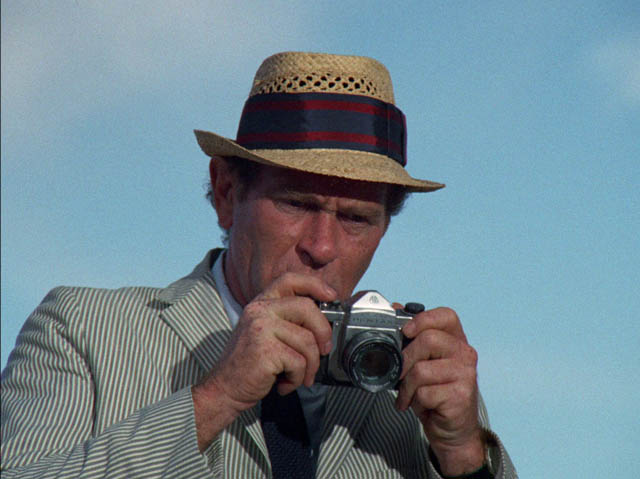
The Night Stalker (John Llewellyn Moxey, 1972)
I’m old enough to have seen John Llewellyn Moxey’s The Night Stalker when it first aired in 1972, one of the most highly touted of that decade’s made-for-TV horrors. Although this genre looks pretty tame now, back in the day network television was one of the best places to get a horror fix. Certainly, corporate standards kept a lid on anything too disturbing, but talented people did manage to inject a creepy atmosphere and occasionally transgressive notes into sometimes familiar stories. No doubt it’s the influence of nostalgia to some degree, but I still have a soft spot for movies I saw back then in my late teens and early twenties. (For all its big budget and slick effects, the 2010 remake of Don’t Be Afraid of the Dark couldn’t match the chills of John Newland’s 1973 original.)
In some ways, The Night Stalker was even more successful than Count Yorga, Vampire (1970) in bringing a classic vampire to modern America, partly because it set the story in the trashy heart of a nation where money and entertainment had supplanted virtually all other values. Barry Atwater’s Janos Skorzeny is a feral beast preying on casino workers and prostitutes in the shadowy alleys off the Strip in Las Vegas, leaving bodies drained of blood and authorities more concerned about the negative impact on the tourist industry than the possibility that a real monster is stalking the city.
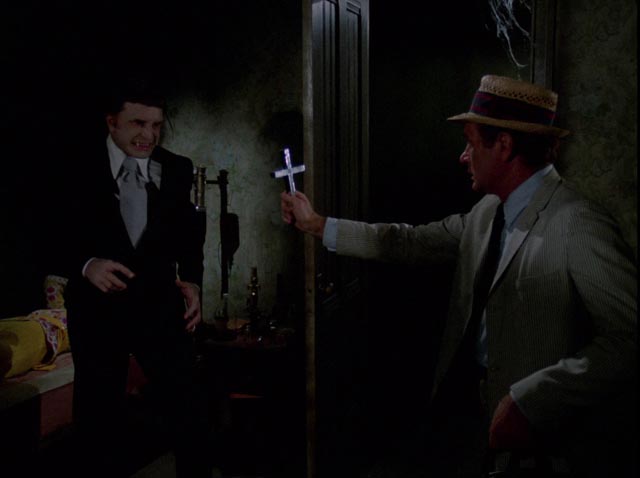
Abrasive newspaperman Carl Kolchak, looking for a big story to get him back to New York, is much quicker than the police department in putting the clues together – even though he initially proposes a serial killer who just thinks he’s a vampire before eventually figuring out that the killer is the real deal. Structurally, the movie prefigures Jaws; the escalating attacks, the conflict between those willing to face the truth and authorities who want to remain willfully blind to it for commercial reasons.
It’s been years since I last saw The Night Stalker and while I still appreciate the atmosphere Moxey draws from Richard Matheson’s script (adapted from an at-the-time unpublished novel by Jeff Rice), I have to admit that this time I found Darren McGavin’s Kolchak kind of annoying – as a version of the classic reporter digging beneath the official story to uncover problematic truths, he’s pushed to such an extreme that he too often comes across as an obnoxious jerk. In scene after scene he’s yelling at someone – the Sheriff (Claude Akins) and Police Chief (Charles McGraw), the District Attorney (Kent Smith), and mostly his editor (Simon Oakland) – and eventually his cocky cynicism undermines the horror, although Skorzeny remains a menacing figure right up to the downbeat twist ending.
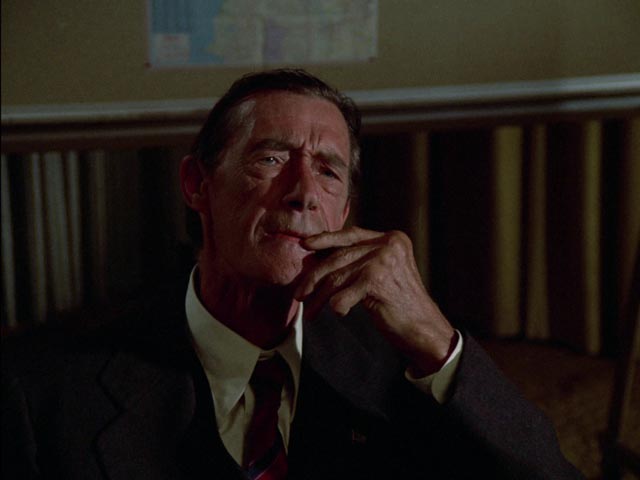
The Night Strangler (Dan Curtis, 1973)
The Night Stalker was such an unexpected hit with viewers that it was inevitable the network would want a follow-up and one year later almost to the day, The Night Strangler aired. An original script by Matheson, it contrived to move both Kolchak and his editor to Seattle where yet another supernatural killer is at work. This time, the movie was directed by producer Dan Curtis, who repeats the abrasiveness and yelling, but has a more heavy-handed style than Moxey, making it more plodding than breezy.
The most interesting aspect of the movie is its use of Seattle’s “Underground City”, fragments of the 19th Century preserved beneath the modern streets (much expanded for the movie, naturally). This is the lair for an immortal killer, a Civil War doctor who discovered the secret of eternal life which requires him to kill a certain number of people over an eighteen-day period every twenty-one years to create his elixir. Kolchak uncovers all the backstory with the help of the man who maintains the newspaper’s archive (Wally Cox), but naturally faces the skepticism of his editor, the police and his aging publisher (John Carradine), not least because he believes that the doctor is actually even older, in fact may be the 18th Century alchemist Comte de Saint-Germain.
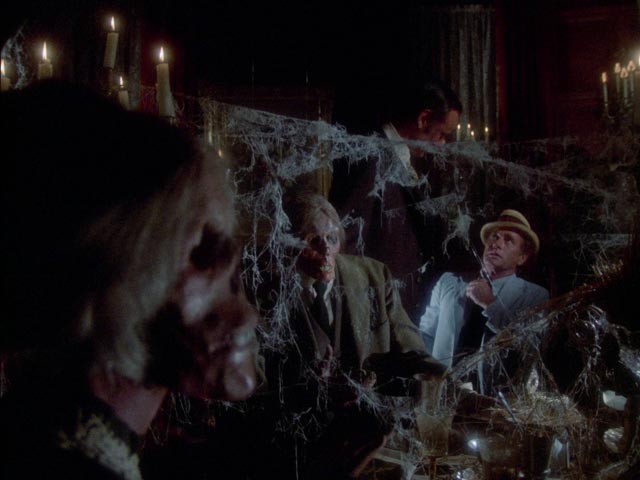
Despite my ambivalence about the films’ protagonist now, they still stand as two of the best ’70s made-for-TV horror movies and Kino have released them both in impressive packages, with multiple new and archival interviews and a commentary from Tim Lucas on each disk. Strangely, Lucas doesn’t mention the similarity of The Night Strangler to Hammer’s The Man Who Could Cheat Death (Terence Fisher, 1959), in which a French sculptor (Anton Diffring) prolongs his life by killing people and using their glands to renew himself.
*
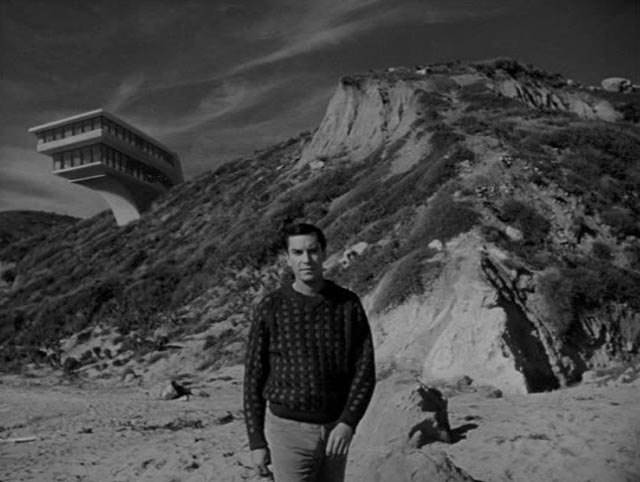
The Ghost of Sierra de Cobre/The Haunted (Joseph Stefano, 1964)
The third, more obscure Kino release is The Ghost of Sierra de Cobre. This disk contains a pilot for a supernatural series created by Joseph Stefano, a creative force behind The Outer Limits second only to Leslie Stevens, and the man who adapted Robert Bloch’s novel for Hitchcock’s Psycho. The show wasn’t picked up and fell into obscurity, but thanks to some collectors it has survived in two forms – the original pilot, titled The Haunted, and a feature-length movie. There are some significant differences between the two, particularly in their endings; the feature, though, feels like a rough cut with some shots and scenes lingering long after they should have been trimmed – either unfinished, or very obviously padded to bring up the running time.
The concept is not unfamiliar: a rational man spends his time investigating supernatural phenomena, looking for proof but no doubt often finding fakery. (Is the title a deliberate nod to Robert Wise’s The Haunting, released just a year earlier?) In this inaugural episode, he gets both. Architect Nelson Orion (Martin Landau), a kind of serious proto-Kolchak, is called in to investigate an apparent haunting. Blind Henry Mandore’s mother, afraid of premature burial, had a phone installed in her tomb and now her neurotic son is receiving calls on the line. His wife (Diane Baker) wants Orion to get to the bottom of it and he does with tragic results.
The calls do turn out to be fake, made by ominous housekeeper Paulina (Dame Judith Anderson reprising her famous role as Mrs. Danvers in Rebecca). But there’s also a real ghost, one linked to a past case in which Orion was involved.
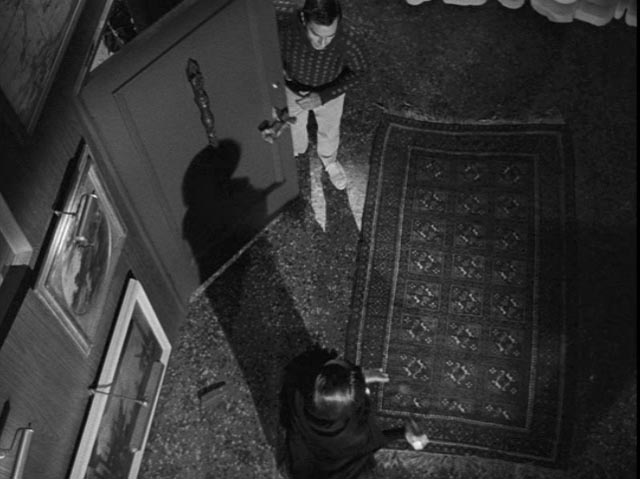
Like the anomalous Outer Limits episode The Forms of Things Unknown, The Haunted was an attempt by Stefano to branch out and create a series of his own. But while the former could be incorporated into The Outer Limits, the latter couldn’t be disguised as science fiction and had nowhere to go when it wasn’t picked up by the network. Nonetheless, its technical qualities reflect the participation of OL regulars, including cinematographer Conrad Hall (who shares a credit here with William A. Fraker). Shot in velvety black-and-white, largely on soundstages, with some location work on the coast, it has an interesting mix of design elements – the Gothic crypt in stark contrast with Orion’s modernist clifftop house. As in his Outer Limits scripts, Stefano here writes dialogue which is quite stylized, allowing for philosophical exchanges about the nature of reality and the problem of knowing anything with any certainty. It should also be noted that this was Stefano’s sole directing credit; he took over when original director Robert Stevens became ill.
In both its versions, this is an interesting curiosity, but I remain unconvinced that it’s some kind of lost masterpiece despite the enthusiasm expressed by commenters David J. Schow (on the long version) and film historian and collector Eric Grayson (whose personal print of The Haunted was used for the transfer of the pilot). Although I found it less interesting than some of Stefano’s other work, it’s exciting that a film like this can be rediscovered and resurrected, on Blu-ray no less, by people willing to invest the time and effort (and money) in something which surely has only a niche audience.
*
Severin
I still haven’t watched all the Severin disks I mentioned back in September, and recently acquired more (and just placed an order for several new releases during their Black Friday sale). The new items include Gerard De Leon and Eddie Romero’s Blood Island Collection (HD upgrades from Image Entertainment’s DVDs, porting over many of the Image extras and adding a few new ones) and Richard Franklin’s Patrick. The new order will bring Sergio Martino’s All the Colors of the Dark along with a collection of more than a hundred giallo trailers, and a set of four mondo features from the ’60s by Lee Frost and Bob Cresse.
I’ve just watched two of the new arrivals, plus a few from the backlog.
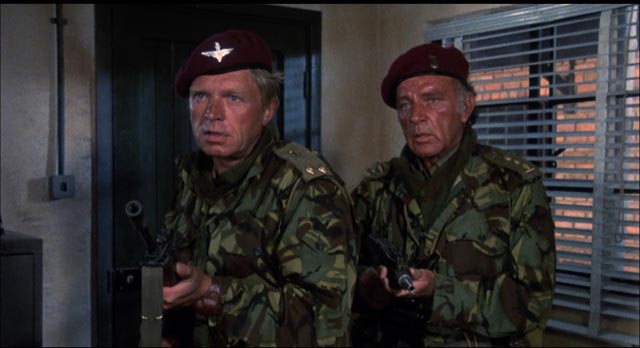
The Wild Geese (Andrew V. McLaglen, 1978)
The Wild Geese (1978) is an old-guy action movie produced by Euan Lloyd, who also produced Who Dares Wins (1982), an anti-terrorist thriller which problematically endorses domestic spying by the police and the subversion of political rights in the name of “security”. The Wild Geese, directed by Andrew V. McLaglen, is also problematic – it belongs to the genre of colonialist adventure movies focused on the fates of white Europeans involved in underdeveloped or developing countries which are seen as deeply corrupt. However, while it doesn’t acknowledge that corruption as a legacy of colonialism, it does at least register the corruption of the developed world as well.
Sir Edward Matherson (Stewart Granger), a wealthy British businessman hoping to regain control of the copper supply in an African country, commissions a group of mercenaries to parachute in and rescue the country’s former president, Julius Limbani (Winston Ntshona), deposed in a military coup and believed dead for the past few years, but actually held in a remote prison. Colonel Allen Faulkner (Richard Burton) tracks down his former comrades to enlist them in the plan, using both money and an argument for “doing the right thing” to convince them to come out of retirement. There’s divorced father Captain Rafer Janders (Richard Harris), who just wants to be a good dad to his young son; Lieutenant Shawn Flynn (Roger Moore), reduced to working for criminals and becoming disgusted with himself; Lieutenant Pieter Coetzee (Hardy Kruger), a former South African security officer with deeply held racist views; and a mixture of fighting men led by Regimental Sergeant Major Sandy Young (Jack Watson), who has to whip everyone including the officers into shape in short order.
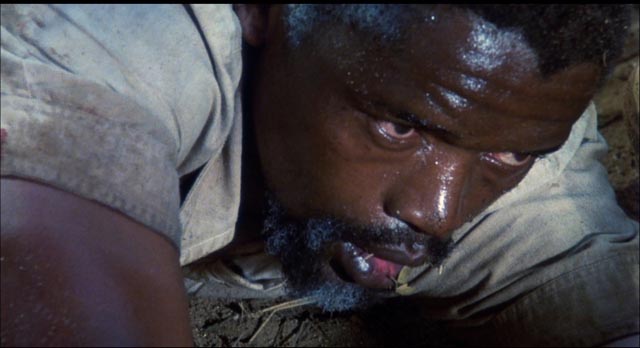
Despite carrying out the rescue mission with precision, the unit suddenly find themselves trapped in hostile territory when Matherson makes a deal with the military government and no longer needs to resurrect the beloved former president. As they fight their way across country, losing more and more men, everyone learns something about themselves – the most squirmingly awkward moment comes when President Limbani manages to convince Coetzee that Blacks and Whites need to work together towards a better future. The argument is so powerful that Coetzee eventually sacrifices himself willingly to save Limbani.
McLaglen was an efficient but uninspired director, managing the logistics and allowing his aging stars to get on with their job of breathing some kind of life into stereotypical characters. The Wild Geese is like a favourite snack food – not actually nutritious, perhaps a little toxic, but you enjoy the taste of it anyway and soon forget that you were eating it.
The disk includes a doc about producer Lloyd which was also on Arrow’s Who Dares Wins Blu-ray, plus a commentary with Lloyd, Moore and second unit director and editor John Glen, who three years later would go on to direct a string of James Bond movies. There are also interviews with director McLaglen and military advisor Mike Hoare, plus a couple of archival clips about the production.
*
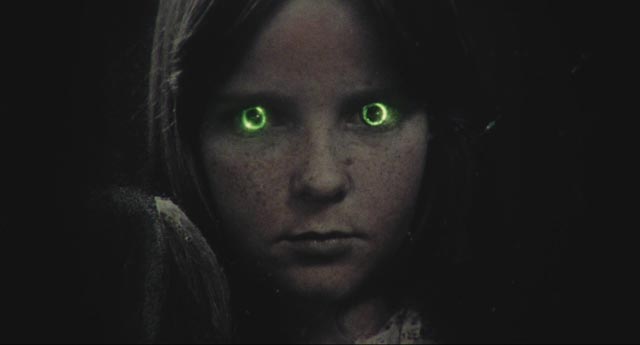
Cathy’s Curse (Eddy Matalon, 1976)
Made for far less money and without stars, Eddy Matalon’s Cathy’s Curse (1976) is in some ways more enjoyable, though not as conventionally well-made. Matalon was a French writer, producer and sometime director, who a year after producing Joseph Losey’s The Romantic Englishwoman (1975) found himself living in Montreal and making a low-budget tax shelter horror movie (which he co-wrote with Myra Clément and Alain Sens-Cazenave). Not what you’d call a good movie, though it does have its fans, Cathy’s Curse belongs to that post-Exorcist trend of stories about possession and/or kids-with-psychic-powers. There’s even a little precursor to Annabelle, in that the possession of Cathy comes through a creepy doll which once belonged to her aunt Laura (Linda Koot), who died in a fiery car crash back in the ’50s, as her angry father took her in pursuit of her mother who’d run away with her brother George.
Years later, George (Alan Scarfe) returns to the old family home with his own family – wife Vivian (Beverly Murray), recovering from a breakdown following the loss of their second child, and young Cathy (Randi Allen). The malign influence of Laura begins even before they get inside the house, but really kicks in when Cathy finds the doll in the attic – with its eyes sewn shut for some reason. Both the housekeeper and the handyman at some point try to get the doll away from her to destroy it (how they know it’s a channel for Laura, who is apparently furious about her premature death, is never clear), and pay a heavy price for their efforts.
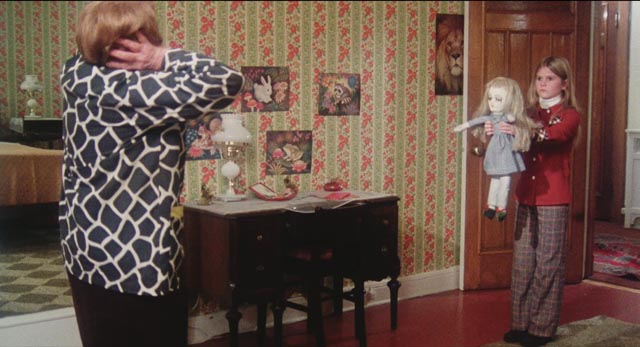
Vivian knows there’s something wrong with Cathy, but busy dad George attributes this to his wife’s fragile mental state and, as always, realizes the truth way too late. Everything in the movie is kind of random – Cathy reenacts the fatal car crash in the garden with the neighbour kids and then almost blinds the little neighbour girl with a nail; she terrorizes the housekeeper with the doll, forcing her to jump to her death from a bedroom window; a decidedly eccentric medium drops in for coffee and senses great danger; when Vivian is readmitted to hospital, busy George leaves Cathy in the charge of alcoholic handyman Paul (Roy Witham), in whom she triggers some serious DTs.
The acting is all over the place, with eleven-year-old Randi Allen quite good as the creepy kid, while Scarfe is rather stilted (showing his stage origins) and Murray occasionally effective as the fragile mother, though she tips into hysteria a bit too frequently. The stand-outs are Mary Morter as the medium and Witham as Paul, both of whom are over-the-top and so eccentric that you could strain a muscle trying to figure out what they might think they’re doing.
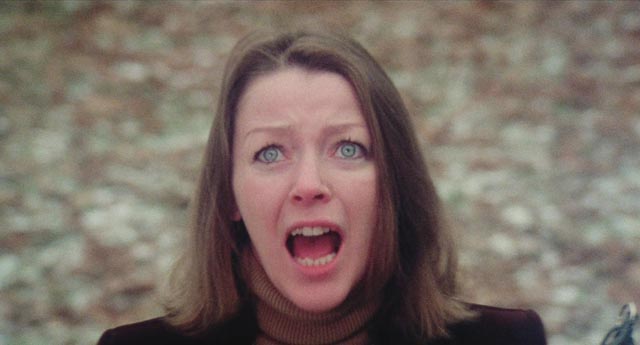
Severin’s disk offers two cuts – the full-length original (91 minutes) and the shorter U.S. theatrical version (82 minutes). The latter is a real hatchet job, which has apparently contributed to fans’ appreciation of the movie as an absurdist delight. Rather than trimming it coherently, the U.S. distributor simply hacked chunks out, occasionally leaving a fragment of a scene which no longer makes sense, dropping bits of expository dialogue which explain some narrative point. The longer version makes more sense to some degree, though admittedly that doesn’t necessarily make it better. But for fans of low-budget exploitation and horror, Cathy’s Curse in either version has a strange charm.
There were a lot of movies made during the tax shelter years (1975 to 1982) and, while some of them were very good (Daryl Duke’s The Silent Partner, Peter Medak’s The Changeling, Louis Malle’s Atlantic City), many seemed to be designed to lose money so that investors could write them off. A lot of them tried to disguise themselves as American, while some were quite happy to be overtly Canadian – David Cronenberg’s Shivers, Rabid and The Brood stand out. With a French writer-director, Canadian cast and crew, and Montreal locations, Cathy’s Curse seems oddly placeless. It could be set in any city, making little use of local colour – although a couple of minor characters have French accents, it’s a completely Anglophone movie. That was a typical tax shelter choice, the aim always being for a sale south of the border.
The disk includes an interview with director Matalon in which he talks cheerfully about the project, and another with star Allen and her mother (who worked in the costume department to be close to her daughter); Allen expresses surprise that anyone shows any interest in the movie today, but obviously had a good time making it – though she had no interest in pursuing an acting career once it was done; it’s her sole credit. There’s also a commentary on the U.S. cut with critic Brian Collins and filmmaker Simon Barrett.
To be continued …
Comments
I like Kino Lorber, I find I have picked up a good number of their discs, especially recently. They certainly do have an eclectic mix of product and some of it’s right up my alley. They also seem to turn up used at Half Price Books on a regular basis. I already had the two Kolchak movies and it’s a good reminder to watch them again. And the series too.
I’d buy more if they weren’t so expensive. In local stores, new disks run from $32.99 to $38.99 on average. I’ve come across a few used ones, but they tend to still be priced around $24.99. I can buy Arrow disks directly from England for a lot less.